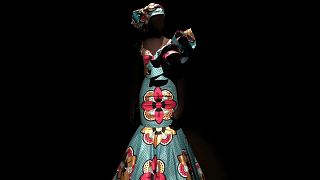South Africa
In Siyabuswa in the Mpumalanga province, South African artist Esther Mahlangu dances with a troupe of athletic Ndebele dancers who visited her home and joins them with a spirited shuffle.
Now frail in her mid-80s, Mahlangu wears traditional necklaces, blankets, beads and fabrics, dressing with the same startling flair that adorns her famous paintings.
South Africa's Ndebele people, one of several ethnic groups of the country's 60 million people, largely live in northeastern parts of South Africa and are known for their distinctive decorations and dress.
Excelling at the traditional craft of painting huts and buildings in lively geometric designs, Mahlangu has taken the generations-old Ndebele craft and won it an acclaimed place in the world of contemporary abstract art.
Most arresting is the spark in her eyes when she discusses her mission of keeping alive the culture of South Africa's Ndebele people.
"For me, it's about the young children. I want them to know my work and learn how to do it like me. I want them to know it so well so that their children can know the Ndebele heritage comes from," Mahlangu says.
Bold blue, yellow, and pink triangles play off each other in a zigzag pattern marching down the side of a rural home in South Africa's northern Mpumalanga province.
Shapes of ziggurats, diamonds and arrows dance around the structure in clashing yet harmonious colours, instantly recognisable as her work.
"I don't have a favourite, I think all the houses I've painted all look beautiful. You only think your work is ugly when you are still starting out and making mistakes," she says.
No longer confined to rural South Africa, Mahlangu's graphic art has enlivened jumbo jets, BMWs and large-scale public installations.
Mahlangu's international success has allowed her to build a spacious compound of several buildings including a gallery and guesthouse — all decorated with her designs.
"What's notable about mam Esther's work is most definitely the colours and the way in which she's able to symmetrically make the colours come alive and not make it feel like a how you say an assault on one's eyes," says Ruzy Rusike, a curator at the Melrose Gallery in Johannesburg, which represents Mahlangu.
Earlier this year Mahlangu suffered an attack when an intruder broke into her home, attempted to strangle her and stole some possessions.
A suspect has been arrested and Mahlangu is still recovering from the trauma.
Although Mahlangu is no longer painting, she champions Ndebele culture from her home.
"I think that goes back into her own understanding of spiritually what colours mean when they see them, but also what contemporary colours mean now," says Rusike.
Rusike says Mahlangu has made her mark on the world art stage because "she's able to, with time, constantly change and reinvent herself".











Go to video
Former South African deputy president David Mabuza dies at 64
00:56
South Africa: At least 101 dead in Eastern Cape floods as rescue efforts continue
Go to video
African gut study reveals urbanization threatens microbial diversity
01:35
Edgar Lungu's family condemns court decision to stop private burial in South Africa
00:52
South African court halts burial of Zambia’s ex-president Edgar Lungu
01:54
South Africa's independent mechanics join forces to compete with big companies